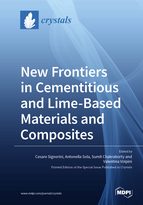New Frontiers in Cementitious and Lime-Based Materials and Composites
A special issue of Crystals (ISSN 2073-4352). This special issue belongs to the section "Inorganic Crystalline Materials".
Deadline for manuscript submissions: closed (30 November 2021) | Viewed by 52069
Special Issue Editors
Interests: textile-reinforced mortar (TRM); cementitious and lime-based materials; fibre-reinforced concrete (FRC); sustainable cementitious materials; recycled aggregates and functional materials; mechanical assessment; long-term performance of cementitious composites
Interests: composite materials; functional materials; cementitious composites; additive manufacturing
Special Issues, Collections and Topics in MDPI journals
Interests: materials chemistry; analytical characterisation techniques; carbon dioxide sequestration; composite for construction; cement and geopolymer; self-healing materials
Interests: composite materials; dielectric composites; smart materials; multiphysics; analytical homogenisation; finite element method; fibre-reinforced concrete (FRC); sustainable cementitious materials
Special Issue Information
Dear Colleagues,
Cement and lime are the classes of inorganic materials used most popularly as primary binders in the construction sector since the ancient period, owing to their global abundance, low cost, and well-established physical and mechanical responses. By tuning the dose of binders with aggregates, water, and additives, a variety of conglomerates can be designed based on their targeted application. These range from fine-grained mortars for plasters to structural concretes with or without fibre reinforcement for buildings, bridges, tunnels, pavements, girders, precast members, walls, screeds, etc.
New frontiers are opening to design viable solutions, which include the development of new, smart, and sustainable concrete/mortar/additive conglomerates/composites with the inclusion of industrial by-products, alternative aggregates, and natural reinforcements. The partial or total replacement of conventional cement and mineral virgin aggregates is pivotal to reduce the environmental concerns and carbon footprint deriving from the manufacturing chain of customary conglomerates that require a substantial amount of energy and resources. Further, the on-going experiments on novel cementitious composite materials for lightweight precast elements and for strengthening laminates for historical buildings represent a ground-breaking research branch in the field. As new materials with embedded functionalities are being proposed every day, scientists gain a deeper understanding of the relationship between the composition, manufacturing, and in-service behaviour of cementitious and lime-based materials and composites.
This Special Issue aims to shed light on the latest research outcomes in this multidisciplinary field, ranging through the vast area of civil, structural, and environmental engineering, mineral and materials science, nano-technology, polymer science, fibre and textiles technology, as well as numerical and statistical design. We welcome high-quality research contributions based on both experimental activities and/or theoretical modelling (numerical/analytical), as well as review articles. The topics of interest include but are not limited to fibre-reinforced composites (e.g., textile-reinforced mortar/concrete (TRM/TRC) and fibre-reinforced concrete (FRC)) and novel sustainable cementitious conglomerates in which the ordinary Portland cement (OPC) binder is replaced with recycled by-products (silica fume, kiln ashes, bio-char, slag, biomass ashes, geopolymers, alkali-activated concrete, etc.) also evaluating the possible incorporation of recycled aggregates.
Original research papers, state-of-the-art reviews, and short communications are encouraged about:
- Fibre-reinforced cementitious conglomerates (FRCC) and their applications;
- Textile-reinforced concrete (TRC) and its applications;
- Textile-reinforced mortar (TRM) and its applications;
- Lightweight concrete mixtures;
- Supplementary cementitious material (SCM) and sustainable binders;
- Alkali-activated materials/geopolymer cements;
- Carbon-dioxide sequestration-based cement materials;
- Natural fibres in inorganic matrix composites for civil engineering applications;
- Concrete mixtures with recycled aggregates;
- High- and ultra-high-performance concrete;
- Self-healing concrete;
- Electrolysed-water-based concrete;
- Micro- and nano-sized functional materials in inorganic-matrix composite materials for civil engineering applications;
- Chemistry and engineering of the matrix-to-fibre interphase;
- Interphase interactions between fibres and inorganic matrices in inorganic-matrix composite materials for civil engineering applications;
- Surface treatments to improve interphase interactions between fibres/aggregates and inorganic matrices in inorganic-matrix composite materials for civil engineering applications;
- Mechanical and rheological performance assessment of cementitious or lime-based composite materials;
- Long-term performance, durability, and corrosion of cementitious or lime-based composite materials;
- Additive manufacturing and emerging production techniques for concrete and composite materials for civil engineering applications;
- Environmental and life-cycle assessment (LCA) of cement-based materials;
- Structural behaviour of composite materials and numerical modelling;
- Design and numerical modelling of composites’ performances;
- Analytical and statistical modelling (regression, FEM, ANN, etc) and structural design and performance.
Dr. Cesare Signorini
Dr. Antonella Sola
Dr. Sumit Chakraborty
Dr. Valentina Volpini
Guest Editors
Manuscript Submission Information
Manuscripts should be submitted online at www.mdpi.com by registering and logging in to this website. Once you are registered, click here to go to the submission form. Manuscripts can be submitted until the deadline. All submissions that pass pre-check are peer-reviewed. Accepted papers will be published continuously in the journal (as soon as accepted) and will be listed together on the special issue website. Research articles, review articles as well as short communications are invited. For planned papers, a title and short abstract (about 100 words) can be sent to the Editorial Office for announcement on this website.
Submitted manuscripts should not have been published previously, nor be under consideration for publication elsewhere (except conference proceedings papers). All manuscripts are thoroughly refereed through a single-blind peer-review process. A guide for authors and other relevant information for submission of manuscripts is available on the Instructions for Authors page. Crystals is an international peer-reviewed open access monthly journal published by MDPI.
Please visit the Instructions for Authors page before submitting a manuscript. The Article Processing Charge (APC) for publication in this open access journal is 2600 CHF (Swiss Francs). Submitted papers should be well formatted and use good English. Authors may use MDPI's English editing service prior to publication or during author revisions.
Keywords
- TRM/TRC composites
- Fibre-reinforced concrete
- Mechanical performance
- Numerical modelling
- Durability
- Fibre reinforcement
- Fibre–matrix interaction
- Natural fibres and textiles
- Hydration
- Hardening
- Nano-engineering









